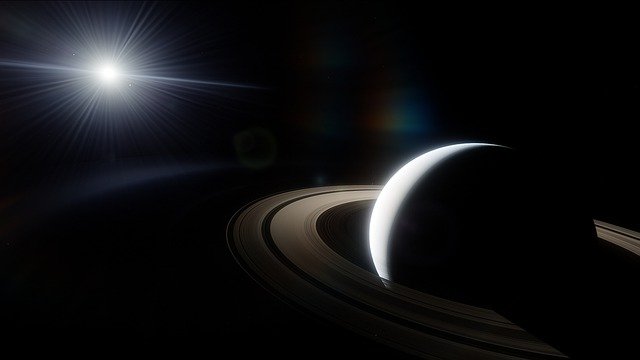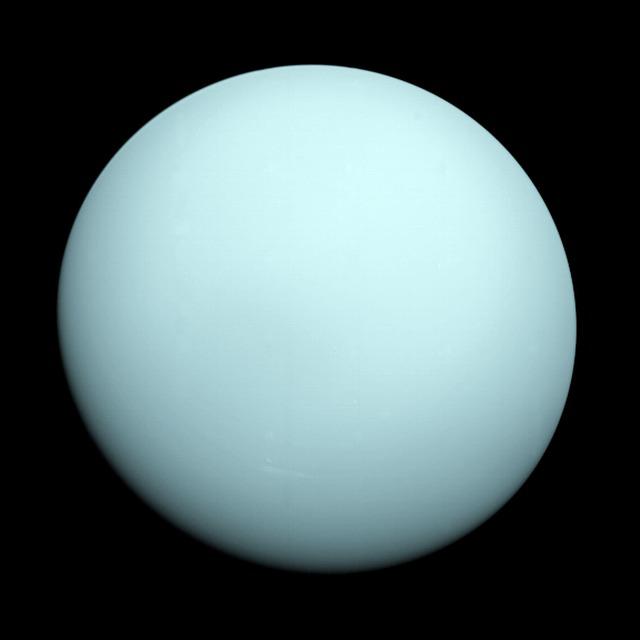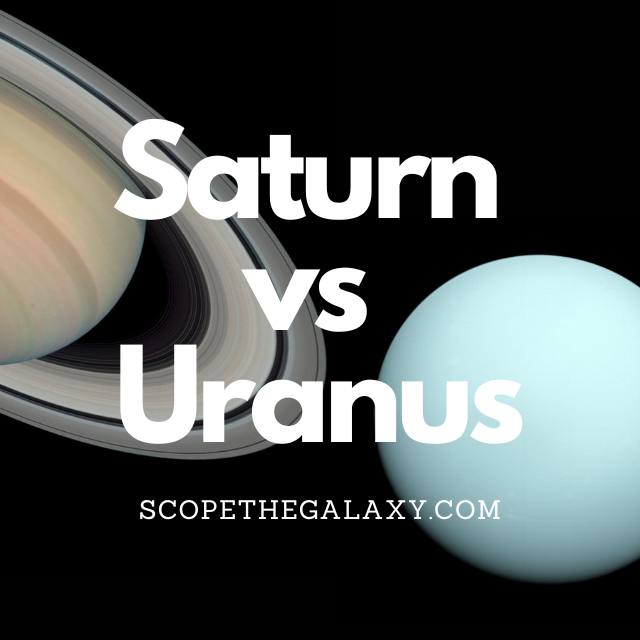*This post may contain affiliate links. This means we may make a commission if you purchase an item using one of our links*
The main differences between Saturn and Uranus is that Saturn is the 6th farthest planet form the sun whilst Uranus is 7th, Saturn is more than twice the diameter of Uranus, Uranus is an ice giant whilst Saturn is a gas giant, Saturn has 82 moons whereas Uranus has 27 and, Uranus is a cyan blue in color whilst Saturn is pale yellow.
Other than these main differences there are numerous others, both similarities and differences, so continue reading if you want more information on this topic.
What Is The Planet Saturn?
Table of Contents

Saturn is the second largest planet in our solar system, that has a multitude of rings surrounding its gaseous exterior. It’s also the 6th farthest planet from the Sun.
As Saturn falls under the gas giant moniker, the planet is mostly made up of gases. However, Saturn’s composition is a little different from Jupiter’s where its atmosphere is mixture of hydrogen and ices containing elements of Ammonia.
It’s core on the other hand is comprised of a dense core of nickel and iron, which is then surrounded by rocks compressed so strongly that it can tends to reach scorching hot temperatures of 11,700+ degrees Celsius.
On the other hand, It’s gaseous atmosphere is far cooler. The exterior generally sits in the extreme sub zero range where Saturn’s temperatures is -138 degrees Celsius.
This is generally constant throughout the yellow ringed giants day to day. In fact it’s much colder than even the coldest place on Earth, which would be Eastern Antarctic Plateau, Antarctica that hits -94 degrees Celsius, which is more than 40 degrees Celsius warmer.
Being so large (116,460km) , Saturn’s gravitational pull is obviously strong. That’s why over it’s 4.5 billion years of existence, beyond its rings this yellow gas giant has managed to accumulate 82 different moons along with other smaller interstellar debris that now orbit it.
In fact it’s largest moon Titan is literally bigger than one of the 8 planets orbiting the Sun, Mercury.
Saturn also orbits the Sun but, as the 6th farthest planet from it, it does mean a singular orbit will take it 29.4 Earth years to complete. In comparison to its axial orbit which only takes 10.7 hours, this is an extremely long time.
What Is The Planet Uranus?

Uranus is the 7th farthest planet from the Sun and the 3rd largest planet in our solar system, coming in at a diameter of 50,724 km. This means that roughly 63 Earth’s could fit inside this ice giant.
In regards to why this cyan blue planet is referred to as an ice giant, it’s down to it’s composition. Uranus is made mostly of methane, ammonia and water with its atmosphere mostly consisting of hydrogen and helium, much like the Sun, and the other giant planets in our solar system.
Due to its distance from the Sun, it takes Uranus 84 years to complete one orbit our central star, whereas it’s axial rotation is much faster than even our Earth at 17 hours per rotation.
As a result of its distance from the Sun, ice based composition and faster rotation levels, Uranus is far from an ideal place to live in let alone have the potential to support life.
Its base temperature is generally a chilling -190 to -200 degrees Celsius and its rocky core, although hot, is still on the cooler side for a large planet sitting around the 5,000 degrees Celsius range.
The planet’s winds are also very fast often hitting 900 km/h, which is roughly twice that of Earth’s most powerful turbulent wind speeds.
In regards to the moons surrounding this cyan planet, we’ve discovered 27 small ones orbiting it. Furthermore, it has 13 rings surrounding it which also means Uranus has the most abundant collection of rings surrounding in our solar system, which is even more than Saturn.
One of the Uranus’ most unique features would include the manner in which it rotates around its axis. As opposed to the slightly angled rotation that the likes of Earth, Saturn and most other planets display, Uranus’ axis is positioned at a 98 degree angle.
What this means is this ice giant completes an axial rotation on its side as opposed to the relatively up straight positioning of most of the other planets in our solar system.
Similarities Between Saturn And Uranus
Saturn and Uranus do have their fair share of similarities. They include the below:
- Both planets have an atmosphere generally composed of hydrogen and helium.
- Both planets are orbiting the Sun.
- Both have a hotter central core.
- Both have multiple moons.
- Both have rings around them.
- Both are a spherical shape.
- Saturn and Uranus are both 4.5 billion years old.
Differences Between Saturn And Uranus
Despite the above similarities, there are a huge variety difference between the 2 also, which would include the following:
- Saturn has 7 rings whilst Uranus has 13.
- Uranus is smaller than Saturn with a diameter 50,724km as compared to 116,460km. What this means is that 63 Earths could fit inside earth whereas 764 Earths would fit inside Saturn.
- Saturn is pale yellow in color whereas Uranus is cyan blue.
- Uranus has 27 moons orbiting whilst Saturn has 82 moons.
- Uranus is the cooler of the 2 with temperatures -190 to -200 degrees Celsius where Saturn is between -135 to -140 degrees Celsius. Even their cores are significantly different temperature where Uranus is around 5,000 degrees Celsius and Saturn’s is around 11,700 degrees Celsius.
- Saturn has an axial tilt at 27 degrees whereas Uranus is practically rotating on its side with an axial tilt of 98 degrees.
- Saturn has the second fastest winds in our solar system, going as a high as 1,800 km/h whereas the max speed in Uranus is around 900 km/h.
- Saturn is the least dense gas giant. Uranus is just above it in this regard.
- Uranus is able to create liquid water whilst Saturn can’t.
- Uranus has the slightly stronger magnetic field at 0.23 gauss on average whereas Saturn’s is around 0.21 gauss.
- It takes Saturn around 10 hours to complete an axial rotation whilst Uranus does it in 17 hours.
- It takes Uranus 84 years to complete an orbit around the Sun whilst Saturn can complete one cycle in 29.4 Earth years.
Summary
Saturn is our yellow gas giant known for its ring and Uranus is known most by its funny name and cyan blue color.
Despite the many similarities both giants have, whether it be their spherical shape, mostly gaseous body and even the planets with the most rings surrounding them, they clearly are worlds apart in many other ways.
This includes size in comparison to one another, their distance from the Sun and even their weather conditions. Then again as is the case with a majority of planets, they’re not necessarily designed to be the exact same even if they share their fair share of commonalities.

